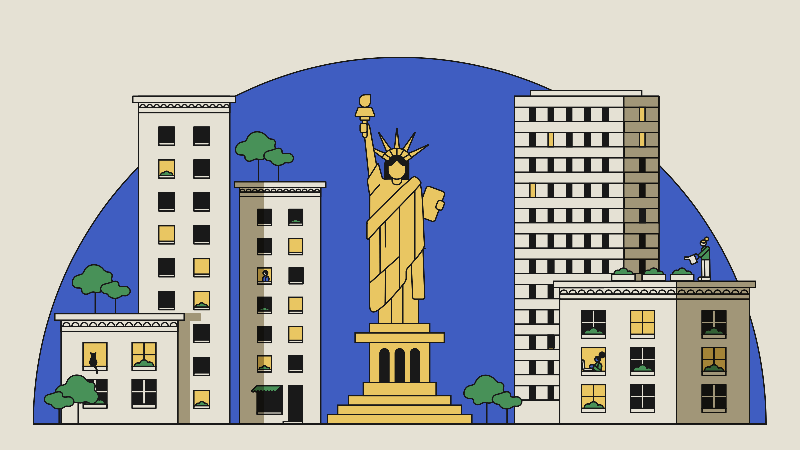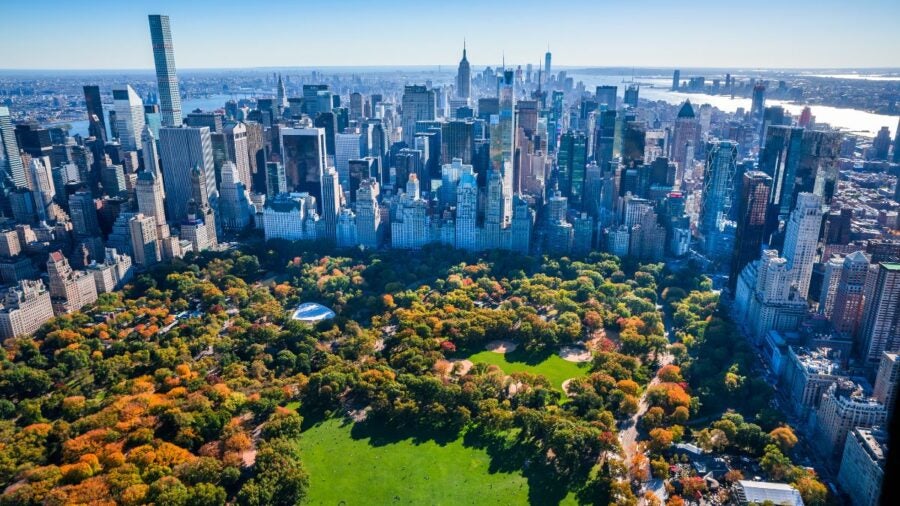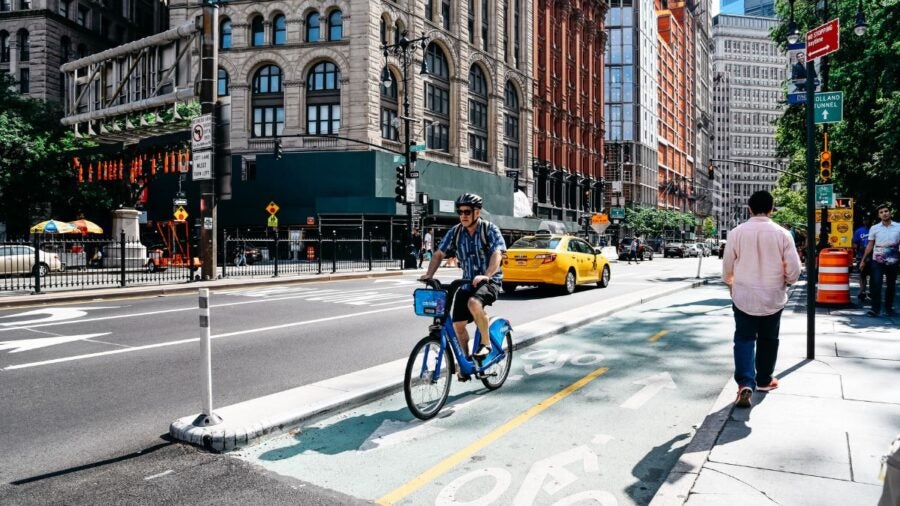
A recent exhibition at the Whitney Museum of American Art focused on Edward Hopper’s paintings of New York: a body of work characterised by isolated figures and desolate streets. Many viewers found it eerily reminiscent of the city during the depths of the Covid crisis.
NYC has since recaptured its pulsating rhythm, with workers flocking back to offices, bars and restaurants, Broadway booming once more and tourists clogging up the sidewalks of Manhattan. And, yes, the Hopper show itself drew large crowds.
Not all is back to how it was before the pandemic, though. Many people still spend part of their week working at home – subway usage is about 20% down on 2019’s figure, for instance.
The rate of inflation in the US has exceeded 9% over the past 12 months and it’s still hovering around the 5% mark, which certainly hasn’t eased the high cost of living in New York. Nonetheless, it remains an alluring destination for the globally ambitious as a centre of finance, media, advertising, tech and the arts.
Getting through the golden door
Be warned that the application process for work-related visas isn’t the easiest. The US offers a range of such schemes, the most popular of which is called H-1B. This visa allows skilled foreign workers to take temporary residence for up to three years, extendable to six. Qualification criteria include a bachelor’s degree or higher and sponsorship by a US employer.
Last year, just over a quarter of the nearly 500,000 H-1B applicants – chosen via an annual lottery – were lucky enough to be selected. From that point, the processing time typically takes between four and eight months.
Transferring within an international company to a US workplace requires an L-1 visa, which also allows for an initial three-year stay that can be extended to seven.
What does it cost to live in New York?
New York has never been a cheap place to live, but inflation and Covid-driven disruptions have made it that much more costly.
‘I’ve always described New York as the real-life Hunger Games’
The median asking rent for residential properties in the city in February was $3,490 (£2,811), according to real-estate site StreetEasy (a good starting point for finding an apartment). In recent years, many professionals have sought more reasonably priced accommodation in Brooklyn and Queens, for instance, where the median asking rents were $3,195 and $2,600 respectively, compared with $4,295 in Manhattan.
How much can I earn In New York?
Pay for New Yorkers has risen over the past couple of years, although not as dramatically as the cost of housing and other essentials. The median salary for all occupations in 2022 was $62,800, according to the New York State Department of Labor.
For certain professions, the rewards are far higher, of course. Last year the median salary for lawyers, for instance, was $200,000; software developers, $132,501; investment analysts, $111,533; and accountants, $100,552.

Those figures don’t include commissions or bonuses, which can make up a large portion of the compensation packages available in certain sectors. This is why a separate analysis reflecting total pay by the New School’s Center for New York City Affairs tends to show higher totals. For instance, the average annual pay of professionals involved in portfolio management and other investment activities was $544,000 in 2021.
But, even for people with six-figure incomes, a high-flying lifestyle isn’t guaranteed. A recent US-wide study by consumer site SmartAsset, which factors in personal taxation and the cost of housing, groceries and utilities, found that a $100,000 salary in New York feels more like $36,000 – the lowest figure of the 76 cities covered in its research.
What is work culture like in New York?
The numbers give some idea of the challenges awaiting expats in New York, but what does it feel like to work there?
“I’ve always described New York as the real-life Hunger Games,” says Juozas Kaziukenas, a Lithuanian ecommerce consultant who worked in the city from 2013 to 2021 and still visits regularly from Vilnius.
He advises aspiring New Yorkers to establish a clear action plan before arriving, as it’s a tough place for those intending to wing it once they’ve got there.
“There’s no sympathy or safety net. It’s very different from many other cities, including most in Europe, which are much more calm and relaxed,” he warns.
The prevalent corporate culture in New York is undoubtedly demanding. Long hours and weekends on call are expected, especially for junior employees in fields such as financial services, consulting, law and tech.
For most New Yorkers, vacation time is typically two weeks off in the summer, along with various national holidays spread throughout the year. Clearing out for August isn’t the norm, but ‘summer Fridays’ are a New York custom whereby workers in sectors such as advertising, media and tech are permitted to leave work early at the end of the week from June to August.
A much newer trend is remote working – a holdover from the Covid lockdowns. As of late January, only 9% of Manhattan office workers were commuting to HQ five days a week, according to a survey by the not-for-profit Partnership for New York City. That contrasts with 70% to 90% office attendance in Europe. Hybrid working seems to be the new norm in New York, with 82% of employers expecting to maintain that arrangement this year.
Don’t sleep on New York’s tech scene
Regardless of where people are working, jobs are back. Sectors hit hardest by the pandemic, such as private education and hospitality, have naturally seen the biggest gains. But the rebound extends more widely. Hiring by tech firms has increased by 21% in the past two years, while recruitment by professional services – including finance, law, advertising and the film industry – has risen 15% over the same period.
Although Wall Street and Madison Avenue continue to command the most attention, New York’s hi-tech industry is vibrant and attractive to expats, according to Kaziukenas.
“Tech events in New York always felt fully busy to me. I never felt like I was working for some kind of fringe industry,” he says.
Indeed, the information services sector accounts for 5% of the city’s employment base – about half that of Wall Street. Employers in this field range from startups to giants such as Google, Facebook and Amazon, all of which have established a significant presence in New York.
Although these companies have cut thousands of jobs around the world in recent months, recruitment in IT departments at non-tech firms in New York remains healthy. Recent research has found that nearly half of all 372,000 IT-related jobs in the city are located at banks, insurance companies and hospitals.
How do New Yorkers kick back?
If New York is a work-obsessed city, its residents are also capable of playing hard too. Many bars and restaurants maintain the kerbside sheds and spaces for outdoor dining that arose from the Covid crisis, with customers spilling out on to the sidewalks in the warmer months.
Much of this activity takes place in downtown Manhattan neighbourhoods such as Greenwich Village, Nolita and the Lower East Side, as well as Williamsburg and Bushwick over in Brooklyn. Local etiquette calls for tips of at least 20% at restaurants. In bars, it’s 20% for a cocktail or $1 for a beer.

For global football fans, New York even offers a smattering of soccer bars, including Smithfield Hall and others around the city aligned with specific Premier League or other European clubs.
Expats seeking to engage in some strenuous exercise of their own may be surprised to learn that the city offers about 1,500 miles of bike lanes, many of which are physically segregated from the roads they run alongside. A highlight is the 32-mile Manhattan Waterfront Greenway (for cycling and walking) that wraps around the island.
Cycling in New York is a useful way to explore the city, according to Kaziukenas, who became an enthusiast after taking advantage of the Citi Bike hire scheme.
“It really opens up your view of how the place is constructed and where you can get to,” he says.
The city’s extensive subway and bus services are available for $2.75 a ride. A 30-day MetroCard for unlimited use will set you back $127.
One place that you should visit by any mode of transport is Central Park, maintained in pristine condition by the not-for-profit Central Park Conservancy. While enjoying this famous green space, you can easily get to the several cultural institutions located on its perimeter, including the American Museum of Natural History, the Guggenheim, the Frick Collection and the Metropolitan Museum of Art.
For culture vultures seeking something more off the beaten track in Manhattan, there’s the Lower East Side Tenement Museum and the Museum of Sex further downtown or the rather more meditative Met Cloisters all the way uptown. There is truly something for everyone in New York – and, even in the city that never knowingly undercharges, you might not have to spend a fortune to enjoy it.

